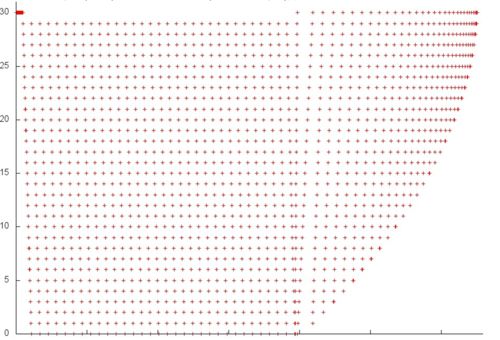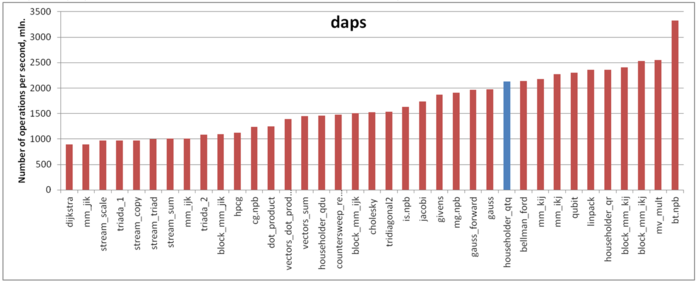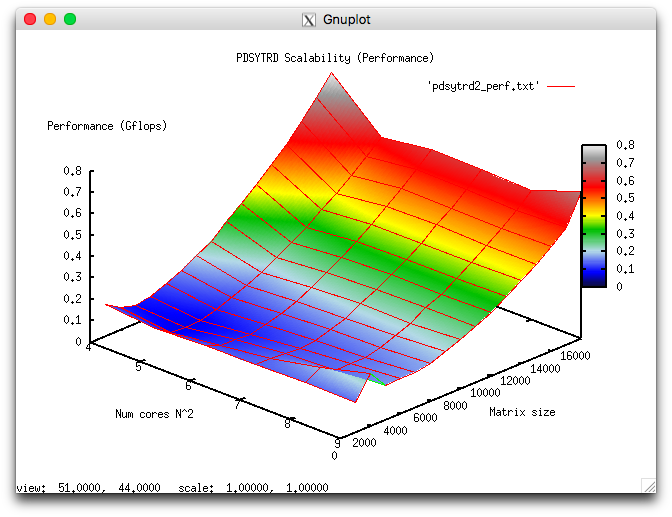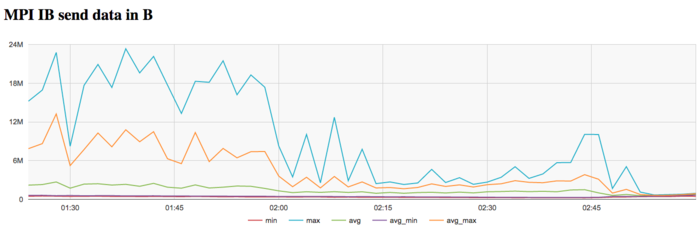Householder (reflections) method for reducing a symmetric matrix to tridiagonal form
| The Householder (reflection) method for reducing symmetric matrices to tridiagonal form | |
| Sequential algorithm | |
| Serial complexity | [math]O(n^3)[/math] |
| Input data | [math](n^2+n)/2[/math] |
| Output data | [math](n^2+3n)/2[/math] |
| Parallel algorithm | |
| Parallel form height | [math]2n^2+O(n)[/math] |
| Parallel form width | [math]n^2/2[/math] |
Primary authors of this description: A.V.Frolov
Contents
- 1 Properties and structure of the algorithm
- 1.1 General description of the algorithm
- 1.2 Mathematical description of the algorithm
- 1.3 Computational kernel of the algorithm
- 1.4 Macro structure of the algorithm
- 1.5 Implementation scheme of the serial algorithm
- 1.6 Serial complexity of the algorithm
- 1.7 Information graph
- 1.8 Parallelization resource of the algorithm
- 1.9 Input and output data of the algorithm
- 1.10 Properties of the algorithm
- 2 Software implementation of the algorithm
- 2.1 Implementation peculiarities of the serial algorithm
- 2.2 Locality of data and computations
- 2.3 Possible methods and considerations for parallel implementation of the algorithm
- 2.4 Scalability of the algorithm and its implementations
- 2.5 Dynamic characteristics and efficiency of the algorithm implementation
- 2.6 Conclusions for different classes of computer architecture
- 2.7 Existing implementations of the algorithm
- 3 References
1 Properties and structure of the algorithm
1.1 General description of the algorithm
The Householder method (which, in Russian mathematical literature, is more often called the reflection method) is used for bringing real symmetric matrices to tri-diagonal form or, which is the same, for obtaining the decomposition [math]A=QTQ^T[/math] (where [math]Q[/math] is an orthogonal matrix and [math]T[/math] is a symmetric tri-diagonal matrix)[1]. The matrix [math]Q[/math] is stored and used not as a full square array but as the product of reflection matrices [2]. Each of these reflections is determined by a vector. For the classical implementation of the reflection method, this makes it possible to store the results of decomposition in place of the matrix A plus additional one-dimensional array.
It is the classical implementation that is discussed here. Techniques like the doubling method for calculating dot products are not used.
1.2 Mathematical description of the algorithm
The Householder method for calculating the [math]QTQ^T[/math] decomposition multiplies the current matrix by a Householder (reflection) matrix on the left and then on the right.
The [math]i[/math]-th step of the method eliminates the nonzero off-diagonal entries in the [math]i[/math]-th column beginning from the [math]i+2[/math]-th entry. For this, the left multiplication by a reflection is used. The right multiplication by the same reflection automatically eliminates the nonzero off-diagonal entries in the [math]i[/math]-th row beginning from the [math]i+2[/math]-th entry; moreover, the resulting matrix recaptures symmetry.
At each step, the reflection is not stored as a conventional square array; instead, it is represented in the form [math]U=E-\frac{1}{\gamma}vv^*[/math], where the vector [math]v[/math] is found from the entries of the current [math]i[/math]-th column as follows:
Let [math]s[/math] be the vector of dimension [math]n+1-i[/math] formed of the entries of the [math]i[/math]-th column beginning from the [math]i[/math]-th entry.
If [math](s,s)=0[/math], then [math]v=e_{i}[/math] and [math]\gamma = \frac{1}{2}[/math].
Otherwise, calculate [math]u = \frac{1}{\sqrt{(s,s)}}s[/math]. Then set [math]v_{j}=0[/math] for [math]j \lt i[/math], [math]v_{j}=u_{j-i+1}[/math] for [math]j \gt i[/math], and [math]v_{i}=1[/math] if [math]u_{1}=0[/math] and [math]v_{i}=\frac{u_{1}}{|u_{1}|}(1+|u_{1}|)[/math], otherwise. Moreover, [math]\gamma = 1+|u_{1}|=|v_{i}|[/math].
After calculating the vector [math]v[/math], one modifies sub-columns located to the right of the pivot column using the formulas [math]x'=x-\frac{(x,v)}{\gamma}v[/math]. Then the rows below the pivot row are modified via similar formulas. Using the already calculated vector [math]v[/math] and the associativity of operations, one can write out modification formulas for all the entries located to the right of and below the pivot column and row. Suppose that, for each column [math]x^{(j)}[/math] indexed by [math]j[/math], we know the number [math]\beta_{j}=\frac{(x^{(j)},v)}{\gamma}[/math]. Then the entry of the matrix [math]y[/math] in position [math](i,j)[/math] is modified according the formula [math]y' = y - \beta_{i} v_{i} - \beta_{j} v_{j} - \Delta v_{i} v_{j}[/math], where [math]\Delta = \frac{(\beta,v)}{\gamma}[/math]. At every step of the algorithm, such modifications for different pairs [math](i,j)[/math] may be performed independently; in particular, they can be carried out in parallel.
1.3 Computational kernel of the algorithm
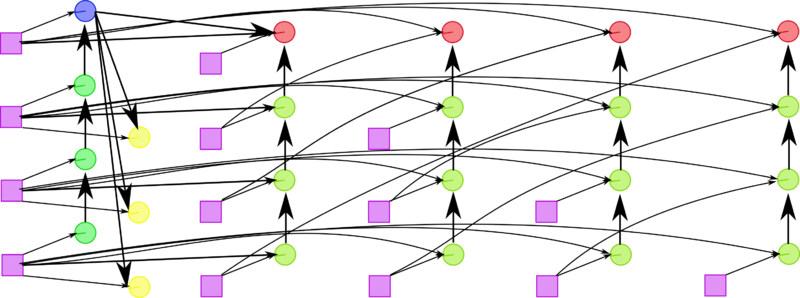
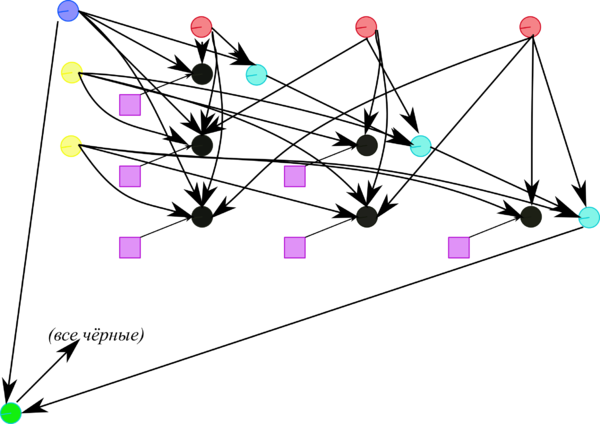
At each step of the algorithm, the bulk of calculations falls on the dot products [math](s,s)[/math] and [math](x,v)[/math] performed for all sub-columns [math]x[/math] located to the right of the pivot column, as well as on operations of the type [math]y'=y-ab-cd-fbd[/math] performed for the lower right sub-matrix with its symmetry taken into account .
1.4 Macro structure of the algorithm
As already said in the description of the computational kernel, the bulk of calculations falls on the dot products [math](s,s)[/math] and [math](x,v)[/math] performed for all sub-columns [math]x[/math] located to the right of the pivot column, as well as on the mass component-wise operations of the type [math]y'=y-ab-cd-fbd[/math]. However, the strict order in performing the first two half-steps is not mandatory. The relationship between the vectors [math]s[/math] and [math]v[/math] makes it possible to calculate the products [math](x,s)[/math] simultaneously with [math](s,s)[/math] and then to express the modification coefficients in terms of these products. This allows us to almost halve the critical path of the algorithm graph.
1.5 Implementation scheme of the serial algorithm
The traditional implementation of the algorithm is a systematic process of eliminating off-diagonal entries in the columns. This process begins from the first column and ends with the penultimate column (that is, column [math](n-1)[/math]).
If the elimination process is applied to column [math]i[/math], then all of its entries with indices from [math](i+1)[/math] to [math]n[/math] are eliminated simultaneously.
The elimination in column [math]i[/math] consists of two steps: (a) The parameters of reflection [math]U_{i}[/math] are calculated. Left multiplication by this reflection effects elimination in column [math]i[/math]. (b) The current matrix is simultaneously multiplied by the reflection [math]U_{i}[/math] on the left and on the right .
1.6 Serial complexity of the algorithm
The serial complexity of this algorithm is mainly determined by vector dot products, as well as mass modifications of the type [math]y'=y-\alpha v - \beta w - \Delta vw[/math]. If we ignore the possible sparsity of the matrix, then these operations require (in the principal term) [math]O(n^3)[/math] real multiplications and additions/subtractions.
Therefore, in terms of the number of serial operations, the Householder method should be regarded as a cubic complexity algorithm.
1.7 Information graph
Figures 1 and 2 show the graph of one step of the Householder method in its fastest version (from the viewpoint of parallel implementation). This version uses the fact that, up to a scalar factor, the vector specifying the reflection differs from the sub-column to be eliminated by only a single entry.
1.8 Parallelization resource of the algorithm
Consider the reduction of a symmetric order [math]n[/math] matrix to tri-diagonal form by the Householder method. In order to understand the parallelization resource of this method, one needs to inspect the critical path of the corresponding graph.
As is seen from the above description, the elimination in the [math]i[/math]-th column involves the calculation of the reflection parameters and certain dot products. These calculations consist of the basic part, which is a branch comprised of [math]2(n-i)[/math] multiplications and additions, and corrections that cost [math]O(1)[/math] operations.
Consequently, by a rough estimate (with terms of lower order dropped), the critical path of the Householder method goes through [math]n^2[/math] multiplications and [math]n^2[/math] additions/subtractions.
Hence, operations of the type [math]a+bc[/math] take the bulk of execution time both in the serial and parallel versions of the algorithm.
Thus, in terms of the parallel form height, the Householder method is qualified as an algorithm of quadratic complexity. In terms of the parallel form width, it also has quadratic complexity. (If the layers related to vector addition operations were not expanded, then the critical path would be doubled.)
1.9 Input and output data of the algorithm
Input data: dense square symmetric matrix [math]A[/math] (with entries [math]a_{ij}[/math]).
Size of the input data: [math](n^2+n)/2[/math].
Output data: tri-diagonal matrix [math]D[/math] (in the serial version, the nonzero entries [math]r_{ij}[/math] are stored in the positions of the original entries [math]a_{ij}[/math]), unitary (or orthogonal) matrix Q stored as the product of Householder matrices (reflections) (in the serial version, their normal vectors to reflection planes are stored in the positions of the original off-diagonal entries [math]a_{ij}[/math] and in an additional column of length n).
Size of the output data: [math](n^2+3n)/2[/math].
1.10 Properties of the algorithm
It is clearly seen that the ratio of the serial to parallel complexity is linear, which yields a certain incentive for parallelization. However, the fastest parallel form has a quadratic width. This indicates an imbalance in the workload of different units when an attempt of actual implementation is made. Even if the computational network is fine (that is, fast), it is more practical to leave the number of units (for instance, cluster nodes) linear with respect to matrix size, which doubles the critical path of the parallel form to be implemented.
The computational power of the algorithm, understood as the ratio of the number of operations to the total size of the input and output data, is linear.
Within the framework of the chosen version, the algorithm is completely determined.
The roundoff errors in the Householder (reflection) method grow linearly, as they also do in the Givens (rotation) method.
2 Software implementation of the algorithm
2.1 Implementation peculiarities of the serial algorithm
Consider the Householder (reflection) method for reducing a real square symmetric matrix to tri-diagonal matrix in the version with a shortest critical path (which uses the relation between the vector under elimination and the vector that determines reflection). This method can be written in Fortran 77 as follows:
DO I = 1, N-2
DO K = I, N
SX(K)=A(N,I)*A(N,K)
END DO
DO J = N-1, I+1, -1
SX(I)=SX(I)+A(J,I)*A(J,I)
END DO
DO K = I+1, N
DO J = N-1, K, -1
SX(K)=SX(K)+A(J,I)*A(J,K)
END DO
DO J = K-1,I+1,-1
SX(K)=SX(K)+A(J,I)*A(K,J)
END DO
END DO
ALPHA = SQRT (SX(I))
IF (A(I+1,I).NE.0.) THEN
BETA = 1./ALPHA
DO J = I+2, N
A(J,I)=A(J,I)*BETA
END DO
SX(I) = A(I+1,I)*BETA+SIGN(1.,A(I+1,I))
A(I+1,I)=ALPHA
G=1./ABS(SX(I)) ! 1/gamma
SX2=0.
DO K = I+2, N
SX(K)=SX(K)*BETA*G+SIGN(A(K,I+1),SX(I))
SX2=SX(K)*A(K,I)+SX2
END DO
SX2=G*SX2
DO K = I+2, N
A(K,K) = A(K,K)-2*A(K,I)*SX(K)+SX2*A(K,I)**2
DO J = K+1, N
A (J,K) = A(J,K)-A(J,I)*SX(K)-A(K,I)*SX(I)+SX2*A(J,I)*A(K,I)
END DO
END DO
ELSE
IF (ALPHA.NE.0.) THEN
BETA = 1./ALPHA
DO J = I+2, N
A(J,I)=A(J,I)*BETA
END DO
SX(I) = -1.
A(I+1,I)=ALPHA
G=1.! 1/gamma
SX2=0.
DO K = I+2, N
SX(K)=SX(K)*BETA*G+SIGN(A(K,I+1),SX(I))
SX2=SX(K)*A(K,I)+SX2
END DO
SX2=G*SX2
DO K = I+2, N
A(K,K) = A(K,K)-2*A(K,I)*SX(K)+SX2*A(K,I)**2
DO J = K+1, N
A (J,K) = A(J,K)-A(J,I)*SX(K)-A(K,I)*SX(I)+SX2*A(J,I)*A(K,I)
END DO
END DO
ELSE
SX(I)=1.
END IF
END IF
END DO
Here, the symmetric tri-diagonal matrix is stored in the locations of the principal diagonal and sub-diagonal of the array A, while the vectors v (without their first components) are stored in the off-diagonal area of this array. The first components are stored in a specially selected array SX.
Usually, in serial versions of the algorithm, the coefficients of column modifications are calculated via dot products after the parameters of reflection have already been found. This slightly simplifies the scheme of the method but extends its critical path. However, this extension is not important for serial realizations.
2.2 Locality of data and computations
According to the graph shown in the figure, there is, unfortunately, a lot of data messaging in the algorithm. Inevitably, some of the arcs in the graph remain long, which negatively affects spatial locality.
2.2.1 Locality of implementation
2.2.1.1 Structure of memory access and a qualitative estimation of locality
Fig.3 shows the memory access profile for an implementation of the Householder (reflection) method. This method reduces a symmetric matrix to tri-diagonal form. The profile obviously has an iterative structure, and, as one can see, its iterations are very similar to each other. The basic difference between iterations is the data set used. At each iteration step, several first elements are dropped from the analysis; that is, the greater the index of iteration, the less data are used. It is also seen that the number of memory accesses slightly decreases at each iteration step. It is sufficient to analyze one iteration in order to understand the overall profile. Let us consider the very first iteration step in more detail.
Fig.4 shows the memory access profile for the first iteration step (in fig.3, it is indicated in green). It can be partitioned into several fragments treated separately. The structure of fragments 2-5 can be understood from the overall graph of the iteration. Fragment 2 is a collection of serial searches performed with a small step in the reverse order. The number of elements inside a search gradually decreases. Such a structure is characterized by a high spatial locality because closely spaced data are often accessed. On the other hand, the temporal locality is low since the data are not used repeatedly. The same is true of fragment 4, whose main difference from fragment 2 is that the searches are done in the direct order. Note that a certain deformation of the former compared with the latter is caused not by the structure of this fragment but by the different number of accesses performed in parallel (for instance, see the right area of fragment 6).
Fragments 3 and 5 consist of a small number of accesses to data located far from each other. Such fragments are characterized by a low spatial and temporal locality.
A more detailed examination is needed for the remaining fragments. Let us inspect fragment 1, which is as a whole shown in Fig.5. Here, we can see several stages; each is a serial search through elements with memory step 1. In certain cases, the data are many times used repeatedly (this is especially noticeable in the lower right area of the figure, where a number of accesses to the same element are performed). If fragment 1 only involves about 40 elements, we can say that this set of accesses has a high spatial and temporal locality.
Now, we consider fragment 6 in detail (see fig.6). Here, we see that repeated accesses to data are performed after certain intervals rather than in succession. However, the number of elements involved is again very small; therefore, in this case as well, the locality (both spatial and temporal) is high.
On the whole, it can be said that this iteration step has a fairly high spatial and temporal locality. Since other steps have a similar construction, this conclusion can be extended to the overall memory access profile.
2.2.1.2 Quantitative estimation of locality
The estimate is based on daps, which assesses the number of memory accesses (reads and writes) per second. Similar to flops, daps is used to evaluate memory access performance rather than locality. Yet, it is a good source of information, particularly for comparison with the results provided by the estimate cvg.
Fig.7 shows daps values for implementations of popular algorithms, sorted in ascending order (the higher the daps, the better the performance in general). It is seen that, here, the performance of memory interaction is sufficiently high. Indeed, the daps value is only slightly smaller than that for the Linpack benchmark. The latter has a fairly high performance, which is slightly higher than that for implementations of the Jacobi method or Gaussian elimination.
2.3 Possible methods and considerations for parallel implementation of the algorithm
2.4 Scalability of the algorithm and its implementations
2.4.1 Scalability of the algorithm
2.4.2 Scalability of of the algorithm implementation
Let us study scalability-out for the implementation of this algorithm in accordance with Scalability methodology. This study was conducted using the Lomonosov supercomputer of the Moscow University Supercomputing Center.
Variable start-up parameters for the algorithm implementation and the limits of parameter variations:
- number of processors [16:81] with the step n^2;
- matrix size [1000 : 16000] with the step 1000.
The experiments resulted in the following range of implementation efficiency:
- minimum implementation efficiency 4.763e-05%;
- maximum implementation efficiency 0.011%.
The following figures show the graphs of the performance and efficiency for the Scalapack procedure PDSYTRD as functions of the variable start-up parameters.
2.5 Dynamic characteristics and efficiency of the algorithm implementation
The experiments were conducted for the implementation of the Householder method within the SCALAPACK package of the Intel MKL library (the pdgehrd subroutine). All the results were obtained with the «Lomonosov-2» supercomputer. We used Intel Xeon E5-2697v3 processors, the FDR Infiniband network, and the Intel compiler with the options suggested by Intel MKL Advisor.
The figures illustrate the efficiency of this implementation of the Householder (reflection) method for reducing symmetric matrices to tri-diagonal form. The order of the matrix was 15000, and 81 cores were used for these runs.
The graph of CPU loading shows that, on the average, the loading is almost all the time about 90 percent. This is a good rate for programs that are run with the use of Hyper Threading technology, that is, all the virtual cores available for this architecture. It is seen that the intensity of calculations is higher at the end of the iteration step compared to the middle part and end of the iteration.
The graph of the number of processes expecting the beginning of the calculation stage (Loadavg) shows that the value of this parameter in the course of the program execution is constant. This value approximately equals to 140 and reduces to 80 only at the end of the iteration step, which indicates that the program performs stably in the course of its execution with 140 threads per node or about 10 threads per physical core at each node. This testifies to a static loading of the hardware resources; however, the number of processes per node is too high, which may indicate that the compilation options are not very reasonable. As a result, the performance may get worse due to overheads for context switching between threads.
The graph of L1 cache misses shows that the number of misses is rather low. On the average, over all the nodes, it approximately equals to 5 millions per second. It is interesting that the number of misses reduces to the end of iteration. This reduction is not too significant; yet, it is quite noticeable.
The graph of L2 cache misses shows that the number of these misses is again rather low. On the average, over all the nodes, it approximately equals to 1 million per second. The graph demonstrates more clearly the reduction in the number of misses to the end of iteration. This reduction is more significant and visible (from 1.2 to 0.5 million) compared to L1 cache misses.
The graph of L3 cache misses shows that the number of these misses is rather low. On the average, over all the nodes, it rapidly decreases from about 90 thousands to 0 per second. This indicates that the problem (especially at the end of iteration) is reasonably matched to the third-level cache memory.
The graph of the data rate through Infiniband network shows that the intensity of use of the communication network is rather low at all iterations. Moreover, the traffic intensity sharply decreases at the end of each iteration. This indicates greater necessity for data exchange between processes at the start of iteration; besides, it shows that the calculations at the end of iteration have reasonable locality.
The graph of the data rate measured in packets per second shows that the maximum, minimum, and average values have lower scatter compared to the graph of the data rate measured in bytes per second. This probably says that the processes exchange messages of different length, which testifies to a non-uniform distribution of the data. Moreover, the traffic intensity increases at the end of each iteration. This makes the distinction especially noticeable.
On the whole, according to the data of systemic monitoring, we can make the conclusion that the program worked stably and used the memory efficiently. The use of memory and communication environment is not sufficiently intensive. This may indicate a reduction in efficiency and an increase in performance when the size of the problem grows considerably. Characteristic features of the parallel implementation accomplished in SCALAPACK are sharp decreases in the number of cache misses and data exchanges at the end of iteration.
2.6 Conclusions for different classes of computer architecture
Compared to the Givens method, which has the natural two-dimensional partition based on the pointwise version, the Householder method is adapted for distributed memory systems worse than for shared memory ones. This is due to the fact that the locality is worse (because of the presence of packet distributions) and the number of independent generalized graph scans is smaller. Consequently, on massively parallel distributed memory systems, one should use the Householder method (if its implementation is required) in its block versions instead of the pointwise version. Note that these block versions are independent methods rather than just a block slicing of the pointwise method. The use of block versions is especially recommended when the matrix is very sparse.
2.7 Existing implementations of the algorithm
Most of packages (from LINPACK and LAPACK to SCALAPACK) choose exactly the Householder method (in various modifications, which usually use BLAS) in order to reduce a symmetric matrix to tri-diagonal form. There is a large amount of research devoted to block versions of this method.



